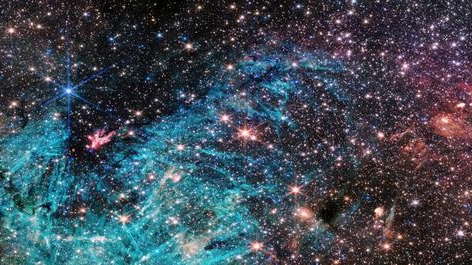The most powerful telescope to ever be aimed at the stars is continuing to reveal stunning new details about outer space, with the most recent image showcasing the dense centre of our galaxy.
NASA released an image snapped by the James Webb Telescope on Monday which shows the centre of our galaxy in never-before-seen detail, including a star-forming region around 300 light years away from the Milky Way’s central black hole.
“There’s never been any infrared data on this region with the level of resolution and sensitivity we get with Webb, so we are seeing lots of features here for the first time,” Samuel Crowe, the observation team’s principal investigator and an undergraduate student at the University of Virginia in Charlottesville, said in a press release. “Webb reveals an incredible amount of detail, allowing us to study star formation in this sort of environment in a way that wasn’t possible previously.”
The region of our galaxy in the image is called Sagittarius C, and contains an estimated 500,000 stars. Researchers characterize it as a factory for new stars, meaning that it could hold answers for some of the ongoing questions experts have.
“The galactic centre is the most extreme environment in our Milky Way galaxy, where current theories of star formation can be put to their most rigorous test,” Jonathan Tan, a professor at the University of Virginia and one of Crowe’s advisers, said in the release.
The dense clouds of gas and dust where high-mass stars form are hard to penetrate with NASA instruments, appearing often in images as a dark blob on the sky that obscures both the stars inside it and beyond it. These are called infrared-dark clouds, meaning that they block even some wavelengths of infrared light, which is invisible to human eyes and invaluable to researchers.
Although even Webb can’t fully see into these clouds, the image released this week provides insights into Sagittarius C that weren’t possible before.
To the untrained eye, the main thing the photo reveals is the beauty of space—it features ghostly clouds of cyan and pink, layered over and under countless shining stars, with ribbons of black looping through.
But astronomers can see so much more.
The darkest part of the image, where there appear to be fewer stars towards the top, is actually an infrared-dark cloud, which only appears to contain fewer stars because it is so densely packed that it is blocking the light from stars beyond it.
The cyan-coloured patches in the image below the infrared-dark cloud are large-scale emissions of ionized hydrogen. This is often the result of photons being emitted by newly formed stars, but the sheer size of this section has surprised researchers. Within this part of the image are also repeated “needle-like” spikes of cyan that seem to extend in random directions, a pattern that astronomers are hoping to investigate further.
“The galactic centre is a crowded, tumultuous place. There are turbulent, magnetized gas clouds that are forming stars, which then impact the surrounding gas with their outflowing winds, jets, and radiation,” Rubén Fedriani, a co-investigator of the project at the Instituto Astrofísica de Andalucía in Spain, said in the release. “Webb has provided us with a ton of data on this extreme environment, and we are just starting to dig into it.”
The image also shows a massive protostar more than 30 times the mass of our Sun, which is emerging from the infrared-dark cloud. The entire region is around 25,000 light-years away from Earth, but still close enough to us for astronomers to study individual stars, according to the release.
“The image from Webb is stunning, and the science we will get from it is even better,” Crowe said. “Massive stars are factories that produce heavy elements in their nuclear cores, so understanding them better is like learning the origin story of much of the universe.”


